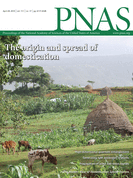Toward a better understanding and quantification of methane emissions from shale gas development
- Dana R. Caultona,1,
- Paul B. Shepsona,b,
- Renee L. Santoroc,
- Jed P. Sparksd,
- Robert W. Howarthd,
- Anthony R. Ingraffeac,e,
- Maria O. L. Cambalizaa,
- Colm Sweeneyf,g,
- Anna Karionf,g,
- Kenneth J. Davish,
- Brian H. Stirmi,
- Stephen A. Montzkaf, and
- Ben R. Millerf,g
- Departments of aChemistry,
- bEarth, Atmospheric and Planetary Science, and
- iAviation Technology, Purdue University, West Lafayette, IN 47907;
- cPhysicians, Scientists and Engineers for Healthy Energy, Ithaca, NY 14851;
- Departments of dEcology and Evolutionary Biology and
- eCivil and Environmental Engineering, Cornell University, Ithaca, NY 14853;
- fNational Oceanic and Atmospheric Administration, Boulder, CO 80305;
- gCooperative Institute for Research in Environmental Sciences, University of Colorado, Boulder, CO 80309; and
- hDepartment of Meteorology, The Pennsylvania State University, University Park, PA 16802
-
Edited* by Barbara J. Finlayson-Pitts, University of California, Irvine, Irvine, CA, and approved March 12, 2014 (received for review September 4, 2013)
Significance
We identified a significant regional flux of methane over a large area of shale gas wells in southwestern Pennsylvania in the Marcellus formation and further identified several pads with high methane emissions. These shale gas pads were identified as in the drilling process, a preproduction stage not previously associated with high methane emissions. This work emphasizes the need for top-down identification and component level and event driven measurements of methane leaks to properly inventory the combined methane emissions of natural gas extraction and combustion to better define the impacts of our nation’s increasing reliance on natural gas to meet our energy needs.
Abstract
The identification and quantification of methane emissions from natural gas production has become increasingly important owing to the increase in the natural gas component of the energy sector. An instrumented aircraft platform was used to identify large sources of methane and quantify emission rates in southwestern PA in June 2012. A large regional flux, 2.0–14 g CH4 s−1 km−2, was quantified for a ∼2,800-km2 area, which did not differ statistically from a bottom-up inventory, 2.3–4.6 g CH4 s−1 km−2. Large emissions averaging 34 g CH4/s per well were observed from seven well pads determined to be in the drilling phase, 2 to 3 orders of magnitude greater than US Environmental Protection Agency estimates for this operational phase. The emissions from these well pads, representing ∼1% of the total number of wells, account for 4–30% of the observed regional flux. More work is needed to determine all of the sources of methane emissions from natural gas production, to ascertain why these emissions occur and to evaluate their climate and atmospheric chemistry impacts.
Footnotes
- ↵1To whom correspondence should be addressed. E-mail: dcaulton{at}purdue.edu.
-
Author contributions: P.B.S., J.P.S., R.W.H., M.O.L.C., and B.H.S. designed research; D.R.C., P.B.S., and R.L.S. performed research; D.R.C., P.B.S., R.L.S., J.P.S., R.W.H., A.R.I., K.J.D., S.A.M., and B.R.M. analyzed data; D.R.C., P.B.S., R.L.S., J.P.S., R.W.H., A.R.I., C.S., A.K., S.A.M., and B.R.M. wrote the paper; and B.H.S. designed and installed aircraft setup.
-
The authors declare no conflict of interest.
-
↵*This Direct Submission article had a prearranged editor.
-
This article contains supporting information online at www.pnas.org/lookup/suppl/doi:10.1073/pnas.1316546111/-/DCSupplemental.








